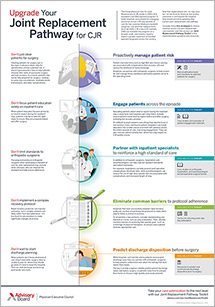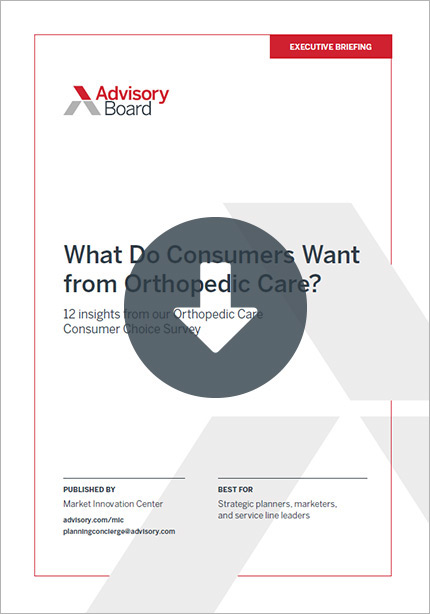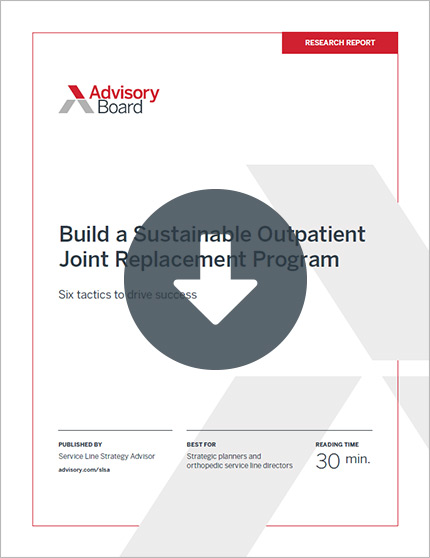Auto logout in seconds.
Continue LogoutRead Advisory Board's take on this story.
Knee replacement surgeries are increasingly popular in the United States, but while the procedure generally is considered safe , as many as one-third of patients continue to experience chronic pain—and some doctors say the surgery often is performed on patients who don't really need it, Liz Szabo reports for Kaiser Health News.
Why are knee replacements growing so popular?
Rates of knee replacements doubled between 1999 and 2008, and researchers expect that by 2030 surgeons will perform 3.5 million knee replacements per year, Szabo reports.
James Rickert, president of the Society for Patient Centered Orthopedics, said the "explosive growth" in the procedure could be due to an increase in knee injuries among patients in their 50s and early 60s. In 2015, 40% of knee replacements were performed on patients between the ages of 45 and 64, up from 30% in 2000. Szabo reports that surgeons are increasingly willing to operate on these "younger" patients, in part because new implant models can last up to 20 years before another replacement is needed.
Hospitals and surgical centers also have a financial stake in attracting knee replacement business. Rickert notes that knee replacements are "really crucial to the financial health of hospitals and doctors' practices," he said, adding, "The doctor earns a lot more if they do the surgery" than if they treat knee pain by other means.
As such, providers increasingly are marketing the procedures to patients, including in TV ads
Why experts say knee replacement isn't a cure-all
But the procedure's public image as a cure-all for knee pain may be misleading, experts suggest.
Nicholas DiNubile, an orthopedic surgeon specializing in sports medicine, said ads for knee replacement often feature post-surgical patients engaging in physical activities, such as bicycling, running, and playing basketball. But she noted that most knee replacement patients are unable to engage in strenuous exercise, such as full-court basketball.
Further, up to one-third of patients who have knee replacement surgery continue to experience chronic pain after the operation, and one in five patients are dissatisfied with the results of the procedure.
One such disappointed patient was Danette Lake, who had her right knee replaced to address arthritis pain that often brought her to the ED and impeded her ability to work. "I thought the knee replacement was going to be a cure," she said. "I got all excited, thinking, 'Finally, the pain is going to end and I will have some quality of life.'"
The doctor told her the surgery could reduce her pain by up to 75%, but about a year after the surgery, Lake said she's still in "constant pain, 24/7." She added, "There are times when I can't even sleep."
Szabo also writes that implants can wear out over time, leading to pain, inflammation, and broken bones. The younger the patient, the more likely it is that their knee replacement will wear out during their lifetime. As a result, 35% of men and 20% of women who had knee replacement surgery under 60 undergo a second surgery, called a "revision" procedure.
Are some knee replacement procedures unnecessary?
Further, some doctors question whether knee replacement procedures are being used appropriately. Szabo cites a study in Arthritis & Rheumatology that found one-third of people who have knees replaced do not have arthritis symptoms that are severe enough to warrant the surgery.
Daniel Riddle, a physical therapy researcher and professor at Virginia Commonwealth University, said patients often are unaware of alternative treatment options that might be as effective as and carry less risk than a knee replacement. For instance, patients in the early stages of arthritis, and some patients with more severe pain, may be better served by physical therapy, over-the-counter pain relief, and dietary changes, Riddle said.
A study published in Osteoarthritis and Cartilage last year revealed that, while patients with non-surgical treatments for knee pain showed less improvement than patients with knee replacements, they experienced fewer treatment complications and were equally satisfied with their progress.
Studies like these suggest that "[w]e do too many knee replacements," Rickert said. "People will argue about the exact amount. But hardly anyone would argue that we don't do too many."
How some industry stakeholders are seeking to rein in knee replacements
To reduce the number of inappropriate joint replacements, some industry stakeholders, including health care company Group Health and insurer Blue Shield of California, are releasing "decision aids" in the form of videos and written materials to educate patients about the procedure.
The decision aids aim to combat misleading advertising and improve doctor-patient communication by highlighting the risks, benefits, and limitations of joint replacement surgery (Szabo, Kaiser Health News, 12/25/2018).
Advisory Board's take


Haley Wiesman, Practice Manager and Sebastian Beckmann, Consultant, Service Line Strategy Advisor
Knee replacements are a highly shoppable procedure and disproportionately consumer-driven. Therefore, a consumer's preference for an 'easy fix' and the pressure to achieve high surgical volumes can sometimes push surgery on non-ideal candidates.
To address this, orthopedic leaders should re-frame their focus to the patient’s central problem: knee pain. And, doing so can actually be a central program differentiator. Indeed, in a market where patients are highly involved in picking their surgeon (35% of 855 respondents in our survey who had prior orthopedic surgery said they actively chose their surgeon), a program with a reputation for surgeons who carefully evaluate surgical options with the patient can make a difference in patient choice.
When our colleagues surveyed over 2,000 orthopedic surgery consumers around the country about what they wanted in a total knee replacement, they found that the patient's perception that the surgeon "takes the time to review my condition and answer my questions" was among the top three most important factors in their decision of surgeon—above the surgeons' quality scores and the facility's reputation.
Therefore, programs should prioritize creating an experience where patients have the time and tools to meet with surgeons and thoroughly discuss their options. For instance, many leading organizations have adopted shared decision making protocols to ensure that patients understand, and are good candidates for, surgery. Then, if patients do decide to move forward, programs should be sure to track their outcomes—not just surgical process measures—to create a robust trove of outcomes data. This data can be used to both to highlight the program's high quality in marketing initiatives and to target future improvement initiatives.
To learn more about the market for knee replacements and other joint replacements—and how it's evolving—be sure to read our new research report on how to Build a Sustainable Outpatient Joint Replacement Program which provides six tactics of how to successfully respond to the joint replacement outpatient shift.
New: Learn how to build a sustainable joint replacement program
Increased payer coverage has moved outpatient joint replacements from differentiator to strategic imperative.
This report helps you navigate the transition to outpatient joint replacements with six tactics to build operational readiness to meet the new market reality, maximize reimbursement and cut costs to maintain margins, and partner with physicians to retain volumes within your health system.
Don't miss out on the latest Advisory Board insights
Create your free account to access 1 resource, including the latest research and webinars.
Want access without creating an account?
You have 1 free members-only resource remaining this month.
1 free members-only resources remaining
1 free members-only resources remaining
You've reached your limit of free insights
Become a member to access all of Advisory Board's resources, events, and experts
Never miss out on the latest innovative health care content tailored to you.
Benefits include:
You've reached your limit of free insights
Become a member to access all of Advisory Board's resources, events, and experts
Never miss out on the latest innovative health care content tailored to you.
Benefits include:
This content is available through your Curated Research partnership with Advisory Board. Click on ‘view this resource’ to read the full piece
Email ask@advisory.com to learn more
Click on ‘Become a Member’ to learn about the benefits of a Full-Access partnership with Advisory Board
Never miss out on the latest innovative health care content tailored to you.
Benefits Include:
This is for members only. Learn more.
Click on ‘Become a Member’ to learn about the benefits of a Full-Access partnership with Advisory Board
Never miss out on the latest innovative health care content tailored to you.




